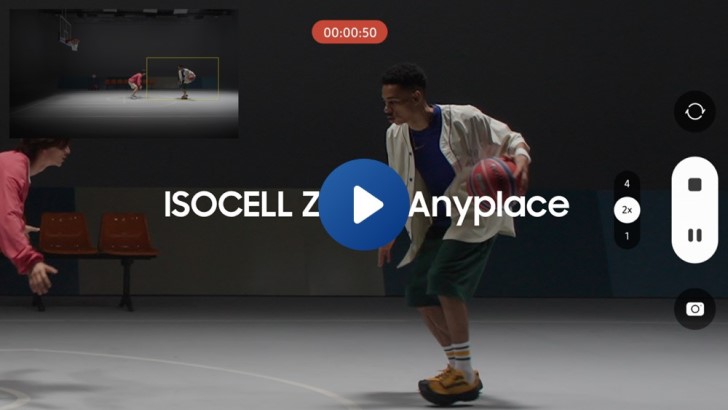Samsung Electronics first launched its 200-megapixel (MP) image sensor in 2021. Since then, the company has been a leader in the super-megapixel industry by constantly releasing new products and tirelessly striving to create more innovation. Such improvements include the use of Dual-VTG and Tetra2Pixel, which has greatly improved Pixel technology. As the company continues its efforts, it will introduce additional solutions to further enhance the high-definition experience. A few of these solutions are of great interest to smartphone users who frequently record video and take photos while wanting to add a more dynamic flavor to their final products.
Zoom and track on any subject, regardless of location
Samsung’s latest video feature, ISOCELL Zoom Anyplace, gives users more freedom and creativity when filming with their smartphones. With the new solution for 200MP image sensors, users can select the desired subject and the camera will automatically track and film it. Until now, users had to focus on a moving subject while filming themselves. But with ISOCELL Zoom Anyplace and the Qualcomm AI engine, the camera quickly finds and tracks a moving subject, making sure it doesn’t get lost during filming. Even fast-moving subjects are prevented from leaving the screen. In addition, videos can be shot with less screen shake.
This feature applies to high resolution zoomed areas as well thanks to real-time remosaic.1 Abilities. ISOCELL Zoom Anyplace takes over the tasks of tracking moving subjects while filming, and users can simply enjoy the scene in front of them with their own eyes.
Previously, if users took a full-screen video and later zoomed in on a subject, the zoomed-in portion suffered from poor video quality. Now, ISOCELL Zoom Anyplace allows users to simultaneously capture the full field of view and zoomed-in areas on video. Not only that, but both full-screen and zoomed views can be recorded simultaneously while maintaining high resolution
This ability to capture full-frame and close-up photos simultaneously opens up creative potential by providing the versatility to capture a scene in multiple ways. As a result, filmmakers can shoot from more angles and can do so more freely and dynamically. Even if the selected subject is at the edge of the screen, users can zoom in on it without changing their full-scope shooting angle. In other words, users can zoom in as much as they like. If they want to start a zoomed-in photo on a subject and then zoom in, they can. If they want to do the reverse, they can do that too. The functions allow for wider artistic choices while filming, which enhances the overall user experience.

Thanks to the zoom of the Tetra sensor2Pixel, users also don’t need to choose due to zoom limitations. Previously, with digital zoom, if the central region of interest (ROI) was zoomed 4x in 12.5MP total mode, it would theoretically achieve a resolution of 0.78MP (12.5MP/16). However, with in-sensor zoom, the area selected for zoom is selected from the entire range and re-mosaiced, allowing the sensor to retain the original 12.5MP resolution and enabling much sharper video. Cameras would switch from wide to tele when zoomed to 3x or more, causing image quality and angle to change. However, the 200MP wide-angle camera can seamlessly zoom 2x or even 4x without losing resolution. Due to this consistent quality, users can now enjoy a true video recording experience.
E2E AI Remosaic for image recording
in addition to Zoom Anyplace as a video solution, Samsung is introducing End-to-End (E2E) AI Remosaic for image capture. Currently, the steps a 200MP image sensor follows to process images after capture are: Raw data output occurs before remosaic, which then leads to Image Signal Processing (ISP) before ending with a JPEG image output. In this process, all the steps are done in sequence.

E2E AI Remosaic improves this process by simultaneously enabling Remosaic and ISP. In other words, E2E AI Remosaic takes a process that happens sequentially and parallelizes it, thereby cutting remosaic latency in half. The end result is generally faster image processing time, which reduces the time it takes to shoot 200MP images and improves image quality. Users can capture and review photos faster, and image quality is less degraded due to data loss due to latency. Because of this, the photos taken will have richer details and colors.
Continuous efforts to improve user experience
Building on the advances made with ISOCELL Zoom Anyplace for video and E2E AI Remosaic for image capture, Samsung Electronics is making great strides in transforming the video and photo experience. Because of solutions like these, a 200MP image sensor launch in 2021 seems like a long time ago. However, improvements like this are part of a long-term plan, as the company continues to work on solutions that improve the user experience even more. We hope that users will continue to look forward to capturing moments with the ultra-high resolution ISOCELL image sensor.
* Images shown were not taken with ISOCELL Zoom Anyplace or E2E AI Remosaic, and are provided for illustrative purposes only of the expected capabilities of a technology still in development.
1 Remosaic: Array transform processing
#Samsung #Electronics #introduces #ISOCELL #Zoom #Anyplace #E2E #Remosaic #solutions #200MP #image #sensor
Image Source : news.samsung.com

